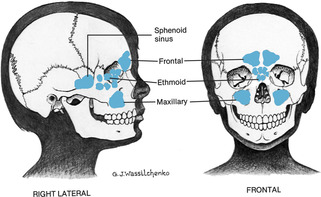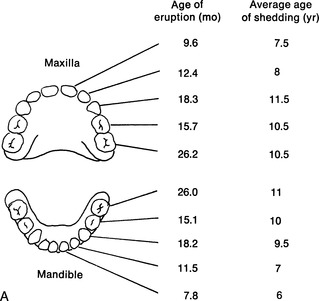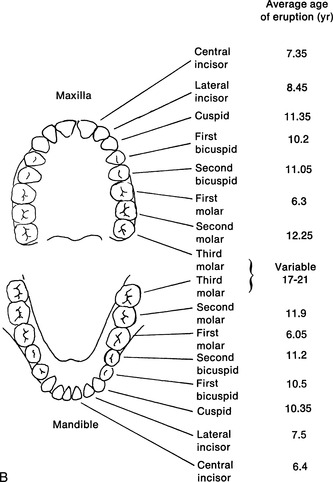Chapter 14. Face, Nose, and Oral Cavity
The face provides a map of the child’s emotional status and clues to neurologic, congenital, and allergic conditions. The nose provides entry to the respiratory tract, and the mouth provides entry to the digestive tract. Examination of the nose, mouth, and sinuses provides information about the functioning of the respiratory and digestive tracts and about the overall health of the child.
The common occurrence of tonsillitis provides reason enough for inspection of the oropharynx; however, examination of the nose, oral cavity, and oropharynx also yields valuable information about congenital anomalies, nutritional status, feeding practices, hydration, hygienic practices, and overall health. The information obtained can be used in the prevention, early detection, and nursing management of such disorders.
Anatomy and Physiology
The face of the newborn infant and child is noticeably different from that of the adult. Typically the neonate appears to have a slightly receding chin. By 6 years of age the mandible and maxilla have grown significantly in length and width and the chin shows greater development. A 6-year-old child has approximately 80% of the facial dimensions of the adult.
Sinuses are air pockets adjacent to the nasal passage. Only the ethmoid and maxillary sinuses are present at birth (Figure 14-1). The frontal sinus develops at around 7 years of age, and the sphenoid sinus develops in adolescence. Development of the sinuses is assisted by enlarging skull bones.
 |
| Figure 14-1Location of sinuses.(From Hockenberry MJ et al: Wong’s nursing care of infants and children, ed 7, St Louis, 2003, Mosby.)Elsevier Inc. |
The nose warms, filters, and moistens air entering the respiratory tract and is the organ of smell. Infants have a narrow bridge and are obligate nose breathers, which readily predisposes them to compromise of the upper airway. The sense of smell is poor at birth but develops with age.
The mouth of the young infant is short, smooth, and has a relatively long, soft palate. The tongue appears large in the shorter oral cavity and tends to press into the concavity of the roof of the mouth, which allows milk to flow back to the pharynx. By 6 months of age the mouth is proportioned like that of the adult. Until approximately 4 months of age the infant demonstrates an active tongue thrust, or extrusion reflex, in which the tongue is pressed under the nipple. This reflex is of concern to some parents, who think that the infant is rejecting solid foods by thrusting them out as soon as they are placed on the tongue. By approximately 6 months of age the rhythmic up-and-down sucking motions of the tongue become the more adult forward-backward tongue movement. The rooting reflex, in which the infant turns the mouth in the direction that the cheek is touched, assists in food attainment and is seen in the infant younger than 3 or 4 months.
Typically the infant of 3 months begins to drool as salivation increases. The increased saliva production, together with an inappropriate swallowing reflex and lack of lower teeth, allows saliva to flow outward.
The sense of taste is immature at birth but becomes acute by 2 to 3 months as taste buds mature; however, the sense of taste is not fully functional until approximately 2 years of age, as evidenced by the strange things that young children ingest.
In newborn infants the gingivae (gums) are smooth, with a raised fringe of tissue along the gum line. Pearlike areas might be seen along the gingivae. These are often mistaken for teeth but are retention cysts and disappear in 1 to 2 months. True dentition begins at approximately 6 months of age, when the lower central incisors appear. By 30 months the child has 20 teeth and primary dentition is complete (Figure 14-1). During middle childhood the permanent molars erupt and the primary teeth are lost. The typical 6 year old appears toothless because of the loss of the middle teeth. Tooth eruptions and losses are genetically predetermined.
 |
 |
| Figure 14-2Primary and secondary dentition. A, Sequence of eruption and shedding of teeth. B, Sequence of eruption of secondary teeth.(From Wong DL: Whaley & Wong’s essentials of pediatric nursing, ed 4, St Louis, 1993, Mosby.)Elsevier Inc. |
Tonsils are found in the pharyngeal cavity and are part of the lymphatic system. Several pairs of tonsils make up Waldeyer’s tonsillar ring, which encircles the pharynx; but only the palatine, or faucial, tonsil is readily visible behind the faucial pillars in the oropharynx (Figure 14-3). The pharyngeal tonsils and adenoids are located on the posterior wall of the oropharynx. Although tonsillar tissue begins to shrink by approximately 7 years of age, the child normally has larger tonsils and adenoids than either the adolescent or adult.
 |
| Figure 14-3Interior structures of mouth.(From Hockenberry MJ et al: Wong’s nursing care of infants and children, ed 7, St Louis, 2003, Mosby.)Elsevier Inc. |
▪ Tongue blade (flavored, if available)
▪ Penlight
▪ Glove
Preparation
Inquire whether the child is a mouth breather or has or has had frequent sore throats; epistaxis; allergies; hay fever; fever; difficulty swallowing; vocal changes (e.g., hoarseness, nasality); or recent contact with persons with communicable disease. Ask about oral hygiene practices and date of last dental visit (if 1 year or older). Ask if the child is receiving medications.
Infants and children find examination of the mouth intrusive, and it is best left until the end of the examination. The nurse often has an opportunity to visualize the oral cavity without a tongue blade when the infant or child cries, laughs, or yawns. Infants and young children are often more comfortable on the parent’s lap during this part of the examination and can be reclined slightly for a better view. Letting the child examine the parent’s mouth or that of a puppet can assist in relieving apprehension about the examination. Having the child tilt the head slightly and breathe deeply can eliminate the need for use of the tongue blade as this will lower the tongue to the floor of the mouth. Infants and young children might need restraining.
Assessment of Face and Nose
| Assessment | Findings |
|---|---|
| Observe the spacing and size of facial features. | Infants who were premature might have a narrow forehead. |
| Clinical Alert | |
| Coarse features combined with a low hairline and large tongue can indicate cretinism. | |
| An enlarged forehead can indicate hydrocephalus or ectodermal dysplasia. |
| Assessment | Findings |
|---|






